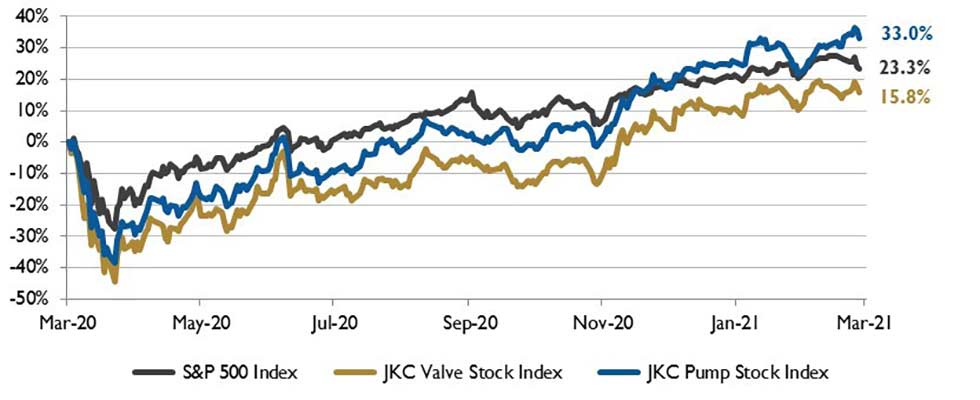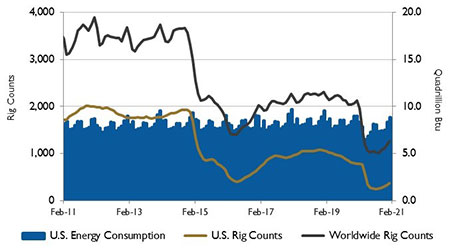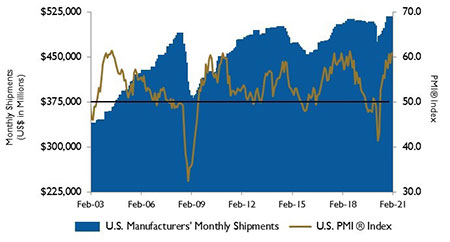
The Jordan Knauff & Company (JKC) Valve Stock Index was up 15.8% over the last 12 months, while the broader S&P 500 Index was up 23.3% and the JKC Pump Stock Index gained 33.0%.1 The Institute for Supply Management’s Manufacturing Report On Business’ Purchasing Managers’ Index (PMI) rose to 60.8% in February. The New Orders Index registered 64.8%, up 3.7 percentage points from the January reading.

The Production Index registered 63.2%, an increase of 2.5 percentage points. All 18 industry groups surveyed reported rising prices in February as the prices paid component jumped to its highest level since July 2008. Labor shortages continued to restrict manufacturing expansion and will remain the main headwind to production growth going forward.
U.S. employment increased by 379,000 jobs in February, with January’s small gain revised up by 117,000. Growth was widespread across industries, amid a rebound in leisure and hospitality (+355,000) and healthcare and social assistance (+46,000). Construction and mining employment fell. Manufacturing employment reversed the prior month’s decline. The unemployment rate went down to 6.2%.

Source: U.S. Energy Information Administration and Baker
Hughes Inc.
The U.S. Energy Information Administration (EIA) projects that growth in natural gas consumption in the United States between 2020 and 2050 will be driven by exports and industrial use as consumption growth from the other sectors will increase slowly or stay flat. Natural gas production will increase to 43.0 trillion cubic feet (Tcf) in 2050 as consumption increases to 35.7 Tcf.
The EIA expects natural gas prices to remain low compared with historical levels, and that low prices will drive the projection of increased production. The EIA expects that exports will rise as production outpaces consumption throughout the period.
With economic growth driving U.S. industrial output, natural gas consumption by the industrial sector will increase by 3.6 Tcf, or 35%, from 2020 to 2050 and account for more than 75% of the growth in U.S. natural gas consumption from all sectors.
Relatively low natural gas prices are projected to drive a growing U.S. chemicals industry (the largest domestic natural gas-consuming industry) because it uses natural gas as a raw material (feedstock) as well as for heat and power. It is estimated that the bulk chemical industry will account for 45% of the industrial sector’s increased natural gas consumption through 2050.

Source: Institute for Supply Management Manufacturing Report
on Business and U.S. Census Bureau
On Wall Street, the Dow Jones Industrial Average, the S&P 500 Index and the NASDAQ Composite gained 3.2%, 2.6% and 0.9%, respectively, in February. Despite the market’s volatility caused by a spike in bond yields, investors remained upbeat due to a new round of coronavirus relief that was approved which included $600 checks going to millions of American households.
The 10-year Treasury note hit 1.6%, the highest level since before the pandemic.
Read more Pump Market Analysis pieces from Jordan, Knauff & Company here.

